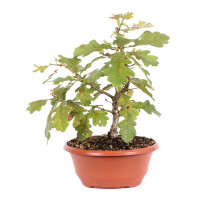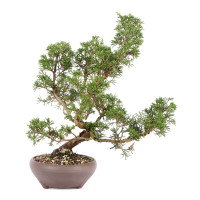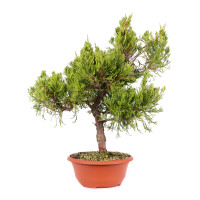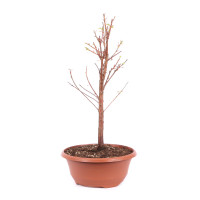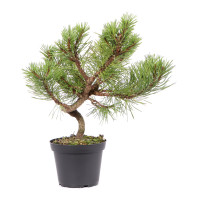- Order number: 1330-P-24-3919
- Height: 35 cm (incl. pot)
- Foliage: evergreen
- Bonsai Pot: plastic pot
- Age: ca. 23 years
- Importjahr: 2024
- Origin: Japan
Juniperus chinensis ‘Itoigawa‘ - Chinese Juniper ‘Itoigawa‘
General:
The Chinese juniper grows in its homeland (China, Mongolia and Japan) as a shrub or tree up to 20 meters high. The habitus is very diverse and influenced by the extreme locations on the coasts and in the mountains. The dark brown bark flakes off in narrow strips over time and then becomes reddish-brown and smooth. Many cultures of the Chinese juniper have emerged over time and can be found in many gardens. Unfortunately, the Chinese juniper is an intermediate host of the pear grate. For this reason, it is now often removed from gardens.
Care as a bonsai:
The Chinese juniper is next to the white pine the best known and most popular conifers for the design of bonsai. The fine evergreen foliage, the flexibility of the wood and the general robustness make the plants an ideal starting material for bonsai design. In Japan you can also find ancient and bizarre junipers in nature. The properties mentioned offer almost unlimited possibilities to rearrange the green of the plant and to design interesting areas of dead wood. The juniper forgives massive interventions here, as long as you give it time to regenerate again and again. A sunny place outdoors is very important for healthy development in summer. In a shady location, the needles will suffer from coloration and the shoots will be long and unsightly. A very bright but protected place is also essential in winter. The reddish-brown discoloration of the needles in winter is normal. In spring, when it gets warmer, the needles turn green again. Even if plenty of watering is necessary in the summer months, waterlogging must be avoided at all costs. The Chinese juniper can withstand short-term drought without damage. The design with topiary and wires is done in the dormancy period from November to March. Repotting takes place from August to September in soil that is well permeable to air and water. Only aphids and spider mites have appeared on junipers of animal pests. However, these can be removed quickly with commercially available pesticides. An optimal location, careful care and adequate nutrition are usually the best preventive plant protection measures.




























